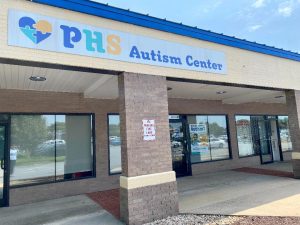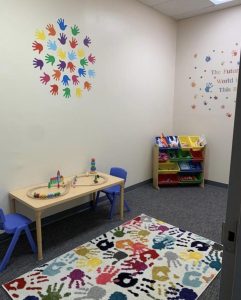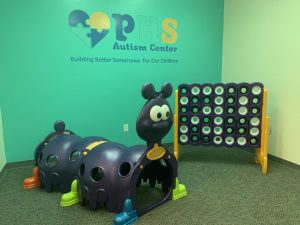A new avenue of help is available in the Martinsville-Henry County community for children on the autism spectrum. The PHS Autism Center, located at 1101 Brookdale Street, Suite B, in Martinsville provides individualized applied behavior analysis (ABA) treatment plans for children ages 2 to 18 who have autism spectrum disorder (ASD).

“There is no one-size-fits-all for a child with autism,” said Progressive Health Systems (PHS) CEO Billie White. At the clinic, “they go through an extensive intake and assessment process and all of that information cumulatively is examined, and an individualized treatment plan is prepared for their specific needs and stage of development.”
White, who said she was a “long-time provider of behavioral services in the Commonwealth” started Progressive Health Systems in 2015, and in 2017 became licensed to provide behavioral health services. As time went on and she explored services to add to the organization and areas where she could make more of an impact with her work, “everywhere I looked, ABA just jumped out at me,” she said.
“The more research we did, it just became evident that it was very sorely needed in the area. We know Martinsville is not a big metropolitan area and has an underserved population,” so she decided to pivot her business to ABA.
Her team began occupying the Brookdale location in January, and the center started accepting clients in May.
ABA, White explained, “is a therapy that’s based on the science of learning and behavior. ABA looks at how behaviors occur, how the environment affects those behaviors, and how those behaviors affect a child’s ability to learn. The program focuses on things like communication, focus, attention, academic skills, social skills, and learning in general.
“We take that knowledge that we gain from the therapy, and we apply it to reduce behaviors that may affect a child’s ability to learn and interact and be able to regulate their emotions,” simultaneously working to “increase helpful behaviors that would support the child’s ability to learn and interact,” she said.

Autistic children “can fall all over that spectrum,” and include those who are fully-nonverbal and cannot appropriately communicate even at a basic level, “all the way up to children that are higher on the spectrum who may have verbal abilities,” White said.
“We work with them through therapies, through play (including simple games like stacking blocks) and ABA uses reinforcers” to reward and incentivize desired behaviors. If a child is able to successfully stack blocks, for instance, “you may offer a child a reward or an incentive, known as a reinforcer, to encourage that behavior.”
Reinforcers, White said, could be anything—a gold star on their paper, a graham cracker, “their reinforcer can be anything that they desire.”
Communication, as is many things, is key. Many undesirable, or maladaptive, behaviors, such as verbal outbursts, kicking, hitting, tantrums, even biting, stem from a child’s inability to communicate their needs and emotions, White said. Through ABA, they have the opportunity to learn the skills to do so.
“It’s all about that fundamental communication to the best of the child’s ability,” she said.
 Social interactions also can be addressed. Children with ASD are oftentimes emotionally detached, so the goal may be for the child to act appropriately when they’re spoken to, she said.
Social interactions also can be addressed. Children with ASD are oftentimes emotionally detached, so the goal may be for the child to act appropriately when they’re spoken to, she said.
“In other words, when you say ‘hello, Johnny,’ you’re teaching the child through reinforcers to be able to make eye contact and respond back or to say their name, to say their colors, letters, numbers, in preparation for the classroom environment.”
The behaviors reinforced by ABA “start at a very fundamental level,” with communication, focus, and attention, “and move all the way up through varied skills. You may be starting with just their ability to communicate appropriately all the way up to being able to brush their teeth” or dress themselves, either independently or with minimal assistance. “It works on a wide range of skills,” White said.
Available services, she said, can be offered in-clinic, in the home, and even in the community. Usually, it is a mix of all three.
Younger children generally rotate between home and clinic, she said, and as they get older, “you can also take them into the community, because the care can be provided in any setting in which the desired behaviors may be expected, or the maladaptive behaviors may occur.”
An older child, for example, may go on a trip to the grocery story “to help them work on handling external stimuli, things that may trigger them. Services can be provided on a multi-facet setting,” determined through the child’s individualized treatment plan, she explained.
White cautioned that while parents may see “small wins” with their child in a matter of weeks, “ABA is designed to be a long-term program as far as early identification and intervention, so we work with these children on a long-term basis,” years, she said, “and build goals on top of one another starting with those foundational things.”
Starting a child on ABA at an early age is most impactful, she said. “Just based on human learning and development, those early years are critical. A child who enters the program, depending on what their treatment needs are or where they fall on the spectrum, you could easily work with a child who is 2 or 3, up through adolescence.”
By the service definition, White said a child can receive ABA therapy until the age of 21, though “what we traditionally see is that a child that gets into the program early may receive services at least through that 8, 10, 12-year range,” by which point, hopefully, they have “gained a lot of those foundational skills” including communication, emotional regulation, and the ability to express their needs in addition to skills in peer interaction and an academic component, allowing the children to function either in a mainstream or inclusion classroom.
Early interventions are possible, she said, because diagnosis rates in autism have made huge advances over the last decade, allowing for even earlier intervention. “Now we’re seeing diagnosis ages falling in the 2- to 3-year-old range, so you’re working with very young children on these basic skills.”
While the center can help children work on behaviors and skills associated with ASD, White said the clinic does not diagnose ADS. The services are offered after a diagnosis is received.
If parents do not yet have an established diagnosis and they have concerns, White said the best place to start is with a primary care physician or pediatrician, who can do a basic screening to determine if there is a valid concern. From there, the child would be referred to a developmental pediatrician who would provide the diagnosis, if appropriate.
White said signs of ADS vary. A child as young as 6 to 9-months old may or may not meet certain developmental milestone markers like sitting up, cooing, making eye contact, or engaging with family members, particularly when their names are called, or a stimulus like a rattle or toy is introduced.
“But it’s very important to know that a child may appear to develop very normally,” White cautioned, “walking on time, developing those first words up until that 18 to 24-month mark, and then they seem to regress and lose words rapidly.”
She said parents may notice the child walking on tip-toes, twirling, or engaging in self-stimulating behaviors like continuously walking, hitting their head on the wall, tapping, twitching, “those repetitive motion behaviors,” she said.
“Also, just a general disconnect. The emotional disconnect is one of the biggest indicators, so those children are not easily engaged. Normally, a neurotypical toddler will see mommy and run to mommy and want hugs and will make eye contact and kiss you on the face. These kids don’t. They’re kind of in their own little world. They’re very emotionally detached, and that can be really hard for parents.”
While there is a great deal of speculation, White said there is no proven cause of autism.
Staffing needs
Since the clinic began accepting clients, White said there has been an influx of referrals. With so many seeking help, she said she does not see an end to the center’s hiring process.
“It’s been overwhelming in the best possible way. Although I knew that there was a need in the area, I was very surprised at just how many referrals we’ve gotten.”
White said the center is in a “continuous hiring process.” All staff members are required to go through rigorous training and an orientation process, depending on their position.
Currently, the clinic is seeking licensed behavior analysts (LBAs) which, outside of Virginia, are more commonly known as board certified behavior analysts (BCBAs) White said.
She also is seeking registered behavior technicians (RBTs), though she said she will hire behavior technicians who are not registered, but will require and sponsor RBT training, which consists of a 40-hour online course, competency evaluations, and a national examination.
Anyone interested in a position with the PHS Autism Center can upload their resume on the center’s website, www.progressivehealthsystems.com, or email info@progressivehealthsystems.com.
White said the website’s referral tab also is the preferred method for referrals or if someone is interested in getting their child into the program. The tab leads users to a HIPAA-compliant, secure form which can be filled out by a parent, pediatrician, case manager, social worker, or foster parent, and will be submitted security back to the office, which is what initiates the eligibility and screening process for possible admission to the program.
For more information about ASD, visit www.autismspeaks.org.




